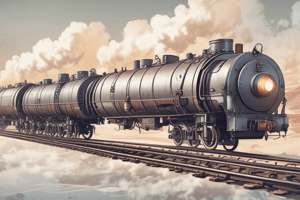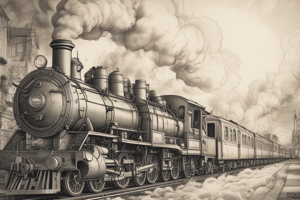Podcast
Questions and Answers
What is the gaseous phase of water called?
What is the gaseous phase of water called?
- Steam (correct)
- Water
- Ice
- Mist
Which of the following is NOT an application of steam?
Which of the following is NOT an application of steam?
- Used in steam turbines
- Used for cleaning in health clinics
- Used in the production of ice (correct)
- Used for food preservation
What defines the characteristics of a substance?
What defines the characteristics of a substance?
- Properties of a substance (correct)
- Phases of matter
- Applications of a substance
- Temperature alone
In which industry is steam primarily used for cooking and sanitization?
In which industry is steam primarily used for cooking and sanitization?
How does pressure relate to the boiling point of water?
How does pressure relate to the boiling point of water?
Which of the following variables is NOT considered a property of steam?
Which of the following variables is NOT considered a property of steam?
What phase of water corresponds to a temperature of 0°C?
What phase of water corresponds to a temperature of 0°C?
Which statement accurately describes the use of steam in hospitals?
Which statement accurately describes the use of steam in hospitals?
What does the variable Csup represent in the formula for the enthalpy of superheated steam?
What does the variable Csup represent in the formula for the enthalpy of superheated steam?
In the formula for calculating the amount of superheat, what does AOS stand for?
In the formula for calculating the amount of superheat, what does AOS stand for?
What role does Tsat play in the enthalpy calculations for superheated steam?
What role does Tsat play in the enthalpy calculations for superheated steam?
What unit is used to express the enthalpy of superheated steam?
What unit is used to express the enthalpy of superheated steam?
When calculating the enthalpy of superheated steam, what must you subtract from Tsup?
When calculating the enthalpy of superheated steam, what must you subtract from Tsup?
What defines the saturation temperature (Ts) in regards to water?
What defines the saturation temperature (Ts) in regards to water?
What is sensible heat (hf)?
What is sensible heat (hf)?
What does latent heat (hfg) represent?
What does latent heat (hfg) represent?
What is the degree of superheat (DOS)?
What is the degree of superheat (DOS)?
What is the formula for calculating the Degree of Superheat (DOS)?
What is the formula for calculating the Degree of Superheat (DOS)?
Which statement correctly describes superheated steam?
Which statement correctly describes superheated steam?
How is the enthalpy of dry saturated steam expressed?
How is the enthalpy of dry saturated steam expressed?
What does the amount of superheat (AOS) indicate?
What does the amount of superheat (AOS) indicate?
What does the Acronym AOS stand for in steam terminology?
What does the Acronym AOS stand for in steam terminology?
What are the three states of steam mentioned?
What are the three states of steam mentioned?
At what point does water convert directly into dry steam without vaporization?
At what point does water convert directly into dry steam without vaporization?
What is the role of latent heat in the process of steam generation?
What is the role of latent heat in the process of steam generation?
What is the critical pressure for water as stated in the content?
What is the critical pressure for water as stated in the content?
Which equation defines the enthalpy of superheated steam?
Which equation defines the enthalpy of superheated steam?
What condition exists at the critical point in terms of phases?
What condition exists at the critical point in terms of phases?
Which of the following represents the relationship for enthalpy of wet steam?
Which of the following represents the relationship for enthalpy of wet steam?
What happens to the energy levels of water as it changes to steam?
What happens to the energy levels of water as it changes to steam?
Why is it important for engineers to understand the properties of steam?
Why is it important for engineers to understand the properties of steam?
At what temperature does ice transition to water?
At what temperature does ice transition to water?
What role does a frictionless piston play in the experiment with water and steam?
What role does a frictionless piston play in the experiment with water and steam?
Which of the following statements about steam is false?
Which of the following statements about steam is false?
What is a correct assumption about steam at constant pressure conditions?
What is a correct assumption about steam at constant pressure conditions?
What is the phase of water at a temperature of 30°C?
What is the phase of water at a temperature of 30°C?
What type of energy change occurs when ice melts into water?
What type of energy change occurs when ice melts into water?
Flashcards are hidden until you start studying
Study Notes
Definition of Steam
- Steam is the vapor form of water, existing in three phases: solid (ice), liquid (water), and gaseous (steam).
Applications of Steam
- Utilized as a working fluid in steam turbines and steam engines.
- Essential in the food processing industry for cooking, pasteurizing, and sanitizing equipment.
- Employed in industries for process heating.
- Used in hospitals for sterilization purposes.
- Applied in health clinics for cleaning.
Properties of a Substance
- A property defines the characteristics or physical conditions of a substance, which include temperature, density, pressure, and mass.
- Changes in the properties of water and steam affect their characteristics and energy levels.
Importance of Studying Steam Properties
- Understanding steam properties aids engineers in controlling devices like steam engines, turbines, and boilers.
- It helps improve operational efficiency in steam-operated machinery.
Formation of Steam
- The formation occurs at constant pressure and can be observed in a setup with water and a frictionless piston.
- The different states of steam include wet steam, dry steam, and superheated steam.
Key Temperature and Enthalpy Concepts
- Saturation Temperature (Ts): The temperature at which water begins to boil at a specified pressure.
- Sensible Heat (hf): Heat required to raise the temperature of 1 kg of water from 0°C to saturation temperature.
- Latent Heat (hfg): Heat needed to convert 1 kg of saturated water into dry steam at the same saturation temperature.
- Superheated Temperature (Tsup): The temperature of steam above its saturation temperature.
- Amount of Superheat (AOS): Heat required to raise 1 kg of dry steam to a desired higher temperature.
- Degree of Superheat (DOS): Difference between superheated temperature and saturation temperature.
Enthalpy Equations
- Enthalpy of Dry Saturated Steam (hg): hg = hf + hfg (kJ/kg)
- Enthalpy of Wet Steam (h): h = hf + x.hfg (kJ/kg)
- Enthalpy of Superheated Steam (hsup): hsup = hf + hfg + Csup (Tsup - Tsat) (kJ/kg)
Critical Temperature and Pressure
- At critical conditions (Tc = 374.15°C, Pc = 221.2 bar), water converts directly to dry steam without vaporization.
- Beyond the critical point, boiling does not occur, and only one phase exists.
Studying That Suits You
Use AI to generate personalized quizzes and flashcards to suit your learning preferences.





